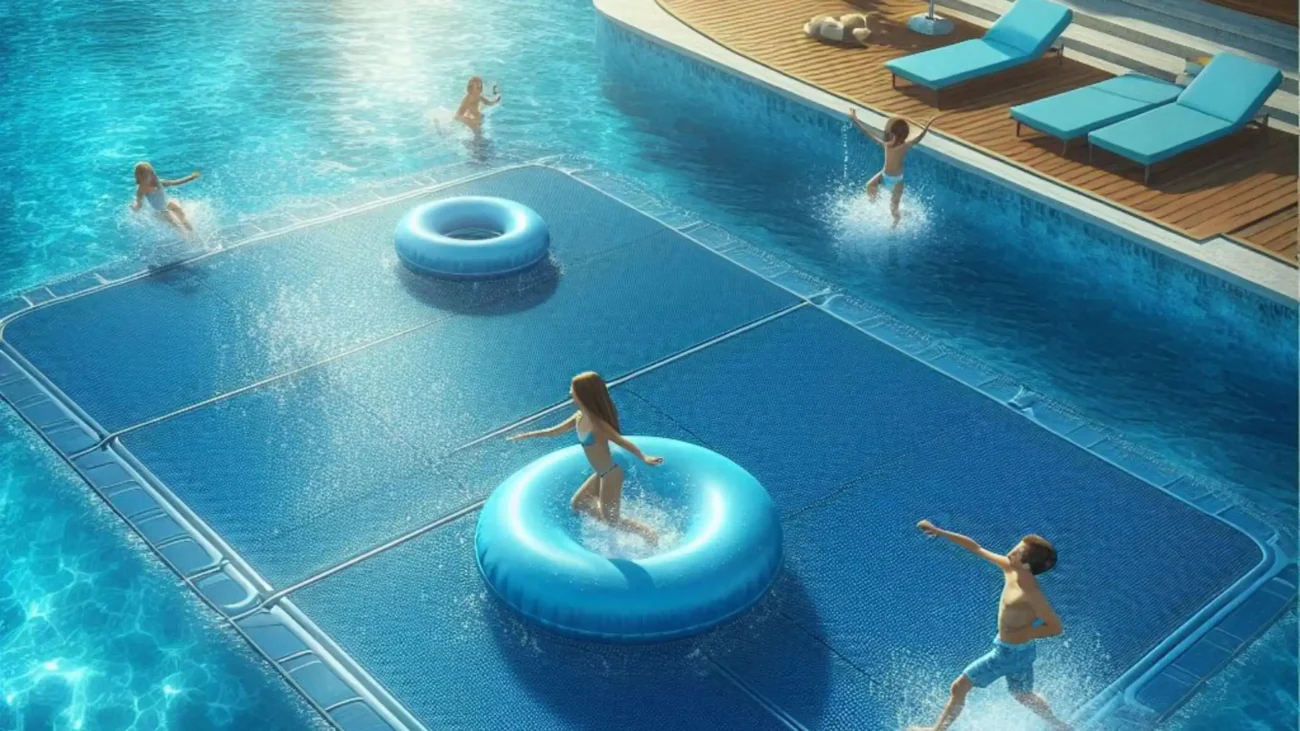Choosing the best color for a solar cover is crucial for maintaining an optimal swimming pool temperature, enhancing aesthetics, and ensuring energy efficiency. Solar covers come in various colors, each with unique benefits and drawbacks. Understanding these can help you make an informed decision that best suits your needs. Solar Gadget
In This Post
Why Solar Cover Color Matters
The color of a solars cover significantly impacts its heat retention and energy efficiency. Different colors absorb and retain heat differently, influencing the pool’s temperature and energy savings. Here, we delve into the science behind each color to determine which is the best for your pool.
Clear Solars Covers: Maximizing Heat Transfer
Clear solar covers are renowned for their ability to maximize heat transfer. These covers allow the most sunlight to penetrate, directly warming the water. This is particularly beneficial in cooler climates where maximum heat absorption is necessary.
Advantages:
- Highest heat transfer efficiency: Clear covers let almost all sunlight through, ensuring the water absorbs maximum heat. Solar Gadget Reviews
- Increased pool temperature: Ideal for cooler climates, as they help increase the water temperature significantly.
Disadvantages:
- Minimal algae prevention: Clear covers do not block sunlight, which can promote algae growth.
- Less privacy: The transparency of clear covers offers less privacy compared to darker covers.

Blue Solars Covers: Balancing Heat Retention and Aesthetics
Blue solar covers are popular due to their balance between heat retention and visual appeal. They offer moderate heat absorption while adding a pleasing blue hue to the pool.
Advantages:
- Good heat retention: Blue covers absorb a significant amount of sunlight, helping to maintain a warm pool.
- Aesthetic appeal: Enhances the visual appearance of the pool with a vibrant blue color.
- Algae prevention: Provides moderate shading, reducing algae growth compared to clear covers.
Disadvantages:
- Moderate heat transfer: While effective, they are not as efficient as clear covers in transferring heat.
- Durability: May not last as long as some other colors, especially under intense sunlight.
Dark Solars Covers: Superior Heat Retention
Dark-colored solar covers, such as black or dark blue, are excellent for retaining heat. These covers absorb sunlight efficiently, ensuring the pool stays warm for longer periods.
Advantages:
- Excellent heat retention: Dark covers trap heat effectively, maintaining a consistent pool temperature.
- Reduced evaporation: The thickness and color help reduce water evaporation, conserving water.
- Enhanced durability: Dark covers are often more durable and resistant to UV rays.
Disadvantages:
- Overheating risk: In extremely hot climates, dark covers may cause the pool to overheat. Solar Guides
- Aesthetic limitations: Dark covers might not be visually appealing to all pool owners.
- Algae growth: Like clear covers, they do not prevent sunlight from reaching the water, potentially promoting algae growth.

Bubble Solars Covers: Innovative Design for Efficiency
Bubble solar covers, available in various colors, feature an innovative design that enhances insulation and heat retention. The air pockets in the bubbles trap heat, providing excellent energy efficiency.
Advantages:
- Efficient heat retention: The bubble design traps heat effectively, ensuring warm water.
- Versatile color options: Available in clear, blue, and dark, each offering different benefits.
- Reduced chemical loss: Minimizes water evaporation, preserving pool chemicals.
Disadvantages:
- Durability issues: The bubble design might be more prone to wear and tear.
- Maintenance: Requires careful handling to avoid damage to the bubbles.
Specialty Solar Covers: Tailored for Specific Needs
Specialty solar covers, such as insulated or dual-color covers, cater to specific requirements. These covers combine features of different colors to provide customized solutions.
Advantages:
- Enhanced performance: Combines benefits of various colors for superior heat retention and aesthetic appeal.
- Custom options: Tailored to meet specific climate and usage needs. Gadget For Travelers
Disadvantages:
- Higher cost: Specialty covers tend to be more expensive than standard options.
- Availability: May not be readily available and might require special ordering.

Choosing the Best Color for Your Pool
When selecting the best color for your solar cover, consider factors such as climate, pool usage, and personal preference. Each color offers unique benefits, making it essential to match the cover to your specific needs.
- Cooler Climates: Clear or blue covers are ideal for maximizing heat absorption.
- Warmer Climates: Dark covers work well to maintain temperature without overheating.
- Aesthetic Preferences: Choose a color that complements your pool area.
- Maintenance: Consider ease of cleaning and durability, especially for darker covers.
Conclusion
The color of your solars cover significantly influences your pool’s temperature, energy efficiency, and maintenance. By understanding the benefits and drawbacks of each color, you can select the optimal cover that aligns with your specific needs and climate conditions.
Frequently Asked Questions (FAQs)
What is the primary purpose of a solar cover?
The primary purpose of a solars cover is to retain heat in swimming pools by absorbing sunlight and preventing heat loss through evaporation. Additionally, solar covers help reduce water evaporation, maintain water cleanliness by keeping debris out, and can decrease energy costs by reducing the need for additional heating.
How does the color of a solar cover affect its performance?
The color of a solar cover affects its performance by influencing heat absorption and retention:
Clear covers: Maximize heat transfer by allowing most sunlight to penetrate, warming the water efficiently.
Blue covers: Balance heat retention and aesthetic appeal, absorbing a good amount of sunlight.
Dark covers: Superior heat retention, ideal for maintaining consistent warmth but may cause overheating in hot climates.
Are clear solar covers better than colored ones?
Clear solar covers are better for maximum heat transfer, making them ideal for cooler climates as they allow most sunlight to penetrate and directly warm the water. However, they are less effective in preventing algae growth and provide less privacy compared to colored covers, which balance heat retention and offer aesthetic and practical benefits.
Why are blue solar covers popular?
Blue solar covers are popular because they offer a balanced combination of heat retention and visual appeal. They absorb a significant amount of sunlight to maintain pool warmth while adding a pleasing blue hue to the water. Additionally, they provide moderate algae prevention by blocking some sunlight and are generally more aesthetically pleasing than clear covers.
Do dark solar covers cause the pool to overheat?
Dark solar covers can cause the pool to overheat in extremely hot climates due to their superior heat retention capabilities. While they are excellent for maintaining consistent warmth, their ability to absorb and retain a large amount of sunlight can lead to higher water temperatures, potentially making the pool uncomfortably warm.
How do bubble solar covers work?
Bubble solar covers work by trapping heat through their innovative bubble design. The air pockets within the bubbles capture and retain heat from the sun, which warms the pool water. This design also reduces water evaporation, conserves pool chemicals, and provides insulation, making the pool more energy-efficient.
What are the advantages of using a specialty solar cover?
Specialty solar covers offer enhanced performance by combining the benefits of different colors and designs. They provide superior heat retention, improved aesthetic appeal, and tailored solutions for specific climates and pool usage. Additionally, they often feature advanced materials and construction for greater durability and efficiency in maintaining pool temperature and reducing energy costs.
How do solar covers help with pool maintenance?
Solar covers help with pool maintenance by reducing water evaporation, retaining heat, and keeping debris out of the pool. This minimizes the need for frequent cleaning and chemical adjustments, conserves water, and helps maintain a consistent pool temperature, ultimately reducing maintenance time and costs.
Can solar covers prevent algae growth?
Solar covers, particularly colored ones like dark or blue covers, can help prevent algae growth to some extent by blocking sunlight from reaching the pool water. This shading effect inhibits algae’s ability to photosynthesize and grow. However, clear solar covers do not provide this benefit as they allow sunlight to penetrate the water, potentially promoting algae growth.
Are there any disadvantages to using a solar cover?
While solar covers offer numerous benefits, there are some disadvantages to consider:
Clear covers may promote algae growth due to sunlight penetration.
Dark covers can cause the pool to overheat in hot climates.
Bubble covers may require careful handling to avoid damage to the bubbles.
Specialty covers can be more expensive and may require special ordering.
Understanding these potential drawbacks can help you make an informed decision based on your specific pool needs and climate conditions.
How should I choose the best color for my solar cover?
When choosing the best color for your solar cover, consider the following factors:
Climate: In cooler climates, clear covers maximize heat absorption, while darker covers are better for maintaining warmth in moderate to warm climates.
Aesthetic Preferences: Choose a color that complements your pool area and enhances its visual appeal.
Practical Considerations: Consider maintenance requirements, such as cleaning ease and durability, especially for darker covers.
By evaluating these factors, you can select a solar cover color that aligns with your climate conditions, aesthetic preferences, and practical needs for maintaining your pool.
Do solar covers save on energy costs?
Yes, solar covers can save on energy costs by reducing heat loss through evaporation and minimizing the need for additional heating. They help retain the heat absorbed from sunlight, maintaining the pool temperature and reducing the workload on pool heating systems. This energy efficiency can lead to significant savings on your overall pool heating expenses.
How long do solar covers typically last?
Solar covers typically last between 3 to 5 years, depending on their quality, usage, and maintenance. Regular cleaning and proper storage can extend their lifespan. Darker covers and specialty covers may have a longer durability due to their materials and construction, making them suitable for prolonged use with proper care.
Can solar covers be used year-round?
Yes, solar covers can be used year-round, though their effectiveness varies with the season. They are most beneficial during warmer months for retaining heat and reducing evaporation. In colder months, while they still provide some insulation, additional heating sources may be necessary to maintain optimal pool temperatures. Proper maintenance and storage during off-seasons help prolong their lifespan and effectiveness.
How should I maintain my solar cover?
To maintain your solar cover effectively:
Regular Cleaning: Rinse the cover with water to remove debris and dirt. Use a mild detergent if necessary, and avoid harsh chemicals that could damage the cover.
Storage: When not in use, store the cover in a cool, dry place away from direct sunlight. This prevents premature degradation and extends its lifespan.
Handling: Handle the cover with care to avoid tears or punctures. Lift and place it gently to prevent damage, especially with bubble covers.
Inspection: Periodically inspect the cover for any signs of wear, such as tears or holes. Repair any damage promptly to prevent it from worsening.
Water Level: Maintain proper water level in the pool to ensure the cover functions correctly and does not sag excessively.
By following these maintenance tips, you can prolong the life of your solar cover and ensure it continues to provide energy savings and maintain pool temperature effectively.
